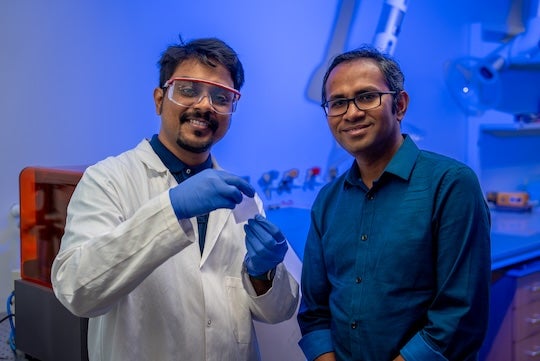Scientists at Rice University and University of Houston have developed an innovative, scalable approach to engineer bacterial cellulose into high-strength, multifunctional materials. The study, published in Nature Communications, introduces a dynamic biosynthesis technique that aligns bacterial cellulose fibers in real-time, resulting in robust biopolymer sheets with exceptional mechanical properties.
Plastic pollution persists because traditional synthetic polymers degrade into microplastics, releasing harmful chemicals like bisphenol A (BPA), phthalates and carcinogens. Seeking sustainable alternatives, the research team led by Muhammad Maksud Rahman, assistant professor of mechanical and aerospace engineering at the University of Houston and adjunct assistant professor of materials science and nanoengineering at Rice, leveraged bacterial cellulose — one of Earth’s most abundant and pure biopolymers — as a biodegradable alternative.

“Our approach involved developing a rotational bioreactor that directs the movement of cellulose-producing bacteria, aligning their motion during growth,” said M.A.S.R. Saadi, the study’s first author and a doctoral student in material science and nanoengineering at Rice. “This alignment significantly enhances the mechanical properties of microbial cellulose, creating a material as strong as some metals and glasses yet flexible, foldable, transparent and environment friendly.”
Bacterial cellulose fibers usually form randomly, which limits their mechanical strength and functionality. By harnessing controlled fluid dynamics within their novel bioreactor, the researchers achieved in situ alignment of cellulose nanofibrils, creating sheets with tensile strength reaching up to 436 megapascals.
Moreover, incorporating boron nitride nanosheets during synthesis resulted in a hybrid material with even greater strength — around 553 megapascals — and improved thermal properties, demonstrating a heat dissipation rate three times faster than control samples.
“This dynamic biosynthesis approach enables the creation of stronger materials with greater functionality,” Saadi said. “The method allows for the easy integration of various nanoscale additives directly into the bacterial cellulose, making it possible to customize material properties for specific applications.”

Shyam Bhakta, a postdoctoral fellow in the Department of BioSciences at Rice, played an important role in advancing the biological aspects of the study. Other Rice collaborators included Pulickel Ajayan, the Benjamin M. and Mary Greenwood Anderson Professor of Materials Science and NanoEngineering; Matthew Bennett, professor of biosciences; and Matteo Pasquali, the A.J. Hartsook Professor of Chemical and Biomolecular Engineering.
“The synthesis process is essentially like training a disciplined bacterial cohort,” Saadi explained. “Instead of having the bacteria move randomly, we instruct them to move in a specific direction, thus precisely aligning their cellulose production. This disciplined motion and the versatility of the biosynthesis technique allows us to simultaneously engineer both alignment and multifunctionality.”

The scalable, single-step process holds significant promise for numerous industrial applications, including structural materials, thermal management solutions, packaging, textiles, green electronics and energy storage systems.
“This work is a great example of interdisciplinary research at the intersection of materials science, biology and nanoengineering,” Rahman added. “We envision these strong, multifunctional and eco-friendly bacterial cellulose sheets becoming ubiquitous, replacing plastics in various industries and helping mitigate environmental damage.”
The research was supported by the National Science Foundation (2234567), the U.S. Endowment for Forestry and Communities (23-JV−11111129-042) and the Welch Foundation (C-1668). The content herein is solely the responsibility of the authors and does not necessarily represent the official views of the funding organizations and institutions.
- Peer-reviewed paper:
-
Flow-induced 2D nanomaterials intercalated aligned bacterial cellulose | Nature Communications | DOI: 10.1038/s41467-025-60242-1
Authors: M.A.S.R. Saadi, Yufei Cui, Shyam Bhakta, Sakib Hassan, Vijay Harikrishnan, Ivan Siqueira, Matteo Pasquali, Matthew Bennett, Pulickel Ajayan and Muhammad Rahman
https://doi.org/10.1038/s41467-025-60242-1 - Access associated media files:
-
https://rice.box.com/s/ap1y4qpylhyzgsjeg1q4r56zckfhrser
Credit: Photos and video - Jorge Vidal/Rice University; the animation used in the video was created by Mario Norton.

